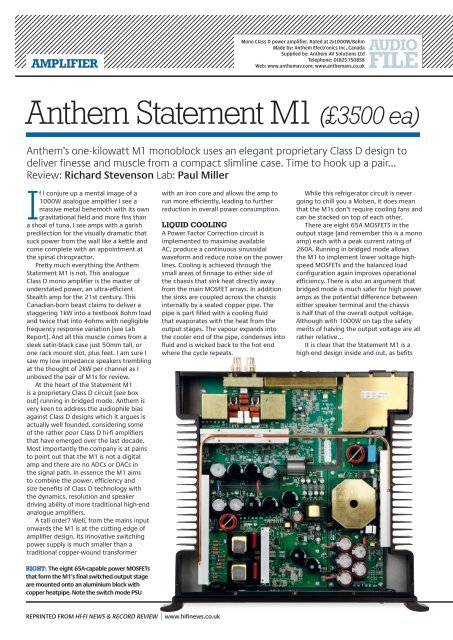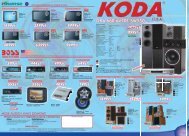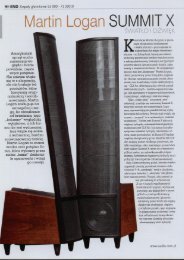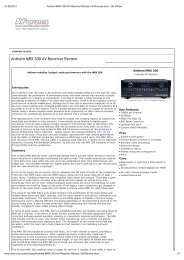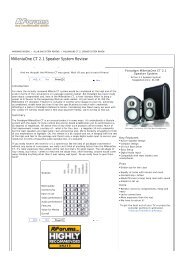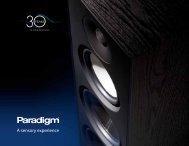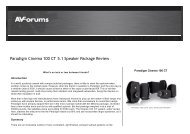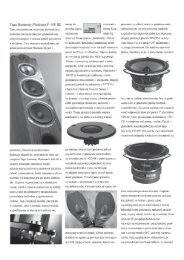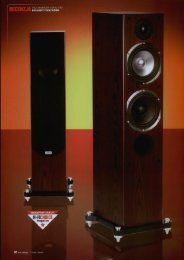Anthem M1 Hi-Fi News March 2012 - Anthem AV Solutions
Anthem M1 Hi-Fi News March 2012 - Anthem AV Solutions
Anthem M1 Hi-Fi News March 2012 - Anthem AV Solutions
Create successful ePaper yourself
Turn your PDF publications into a flip-book with our unique Google optimized e-Paper software.
AMPLIFIER<br />
Mono Class D power amplifier. Rated at 2x1000W/8ohm<br />
Made by: <strong>Anthem</strong> Electronics Inc, Canada<br />
Supplied by: <strong>Anthem</strong> <strong>AV</strong> <strong>Solutions</strong> Ltd<br />
Telephone: 01825 750858<br />
Web: www.anthemav.com; www.anthemavs.co.uk<br />
<strong>Anthem</strong> Statement <strong>M1</strong> (£3500 ea)<br />
<strong>Anthem</strong>’s one-kilowatt <strong>M1</strong> monoblock uses an elegant proprietary Class D design to<br />
deliver finesse and muscle from a compact slimline case. Time to hook up a pair...<br />
Review: Richard Stevenson Lab: Paul Miller<br />
If I conjure up a mental image of a<br />
1000W analogue amplifier I see a<br />
massive metal behemoth with its own<br />
gravitational field and more fins than<br />
a shoal of tuna. I see amps with a garish<br />
predilection for the visually dramatic that<br />
suck power from the wall like a kettle and<br />
come complete with an appointment at<br />
the spinal chiropractor.<br />
Pretty much everything the <strong>Anthem</strong><br />
Statement <strong>M1</strong> is not. This analogue<br />
Class D mono amplifier is the master of<br />
understated power, an ultra-efficient<br />
Stealth amp for the 21st century. This<br />
Canadian-born beast claims to deliver a<br />
staggering 1kW into a textbook 8ohm load<br />
and twice that into 4ohms with negligible<br />
frequency response variation [see Lab<br />
Report]. And all this muscle comes from a<br />
sleek satin-black case just 50mm tall, or<br />
one rack mount slot, plus feet. I am sure I<br />
saw my low impedance speakers trembling<br />
at the thought of 2kW per channel as I<br />
unboxed the pair of <strong>M1</strong>s for review.<br />
At the heart of the Statement <strong>M1</strong><br />
is a proprietary Class D circuit [see box<br />
out] running in bridged mode. <strong>Anthem</strong> is<br />
very keen to address the audiophile bias<br />
against Class D designs which it argues is<br />
actually well founded, considering some<br />
of the rather poor Class D hi-fi amplifiers<br />
that have emerged over the last decade.<br />
Most importantly the company is at pains<br />
to point out that the <strong>M1</strong> is not a digital<br />
amp and there are no ADCs or DACs in<br />
the signal path. In essence the <strong>M1</strong> aims<br />
to combine the power, efficiency and<br />
size benefits of Class D technology with<br />
the dynamics, resolution and speaker<br />
driving ability of more traditional high-end<br />
analogue amplifiers.<br />
A tall order? Well, from the mains input<br />
onwards the <strong>M1</strong> is at the cutting edge of<br />
amplifier design. Its innovative switching<br />
power supply is much smaller than a<br />
traditional copper-wound transformer<br />
with an iron core and allows the amp to<br />
run more efficiently, leading to further<br />
reduction in overall power consumption.<br />
liquid cooling<br />
A Power Factor Correction circuit is<br />
implemented to maximise available<br />
AC, produce a continuous sinusoidal<br />
waveform and reduce noise on the power<br />
lines. Cooling is achieved through the<br />
small areas of finnage to either side of<br />
the chassis that sink heat directly away<br />
from the main MOSFET arrays. In addition<br />
the sinks are coupled across the chassis<br />
internally by a sealed copper pipe. The<br />
pipe is part filled with a cooling fluid<br />
that evaporates with the heat from the<br />
output stages. The vapour expands into<br />
the cooler end of the pipe, condenses into<br />
fluid and is wicked back to the hot end<br />
where the cycle repeats.<br />
While this refrigerator circuit is never<br />
going to chill you a Molsen, it does mean<br />
that the <strong>M1</strong>s don’t require cooling fans and<br />
can be stacked on top of each other.<br />
There are eight 65A MOSFETS in the<br />
output stage (and remember this is a mono<br />
amp) each with a peak current rating of<br />
260A. Running in bridged mode allows<br />
the <strong>M1</strong> to implement lower voltage highspeed<br />
MOSFETs and the balanced load<br />
configuration again improves operational<br />
efficiency. There is also an argument that<br />
bridged mode is much safer for high power<br />
amps as the potential difference between<br />
either speaker terminal and the chassis<br />
is half that of the overall output voltage.<br />
Although with 1000W on tap the safety<br />
merits of halving the output voltage are all<br />
rather relative…<br />
It is clear that the Statement <strong>M1</strong> is a<br />
high-end design inside and out, as befits<br />
RIGHT: The eight 65A-capable power MOSFETs<br />
that form the <strong>M1</strong>’s final switched output stage<br />
are mounted onto an aluminium block with<br />
copper heatpipe. Note the switch mode PSU<br />
Reprinted from hi-fi news & record review | www.hifinews.co.uk
the £7000 outlay for stereo configuration.<br />
Nice touches include hand-designed fourlayer<br />
PCBs with heavy copper tracks to<br />
reduce circuit resistance, extensive use of<br />
power and ground planes keep the noise<br />
floor in the basement and the elimination<br />
of relays in the signal path that could fail<br />
or hamper ultimate sound reproduction. A<br />
sophisticated monitoring and DSP system<br />
runs outside of the signal path, sensing<br />
output current, line current, ground faults,<br />
temperature and DC voltage at the output.<br />
The chassis itself feels solid and well<br />
engineered, with switched rear panel<br />
connections for both balanced XLR and<br />
RCA input. Power-on can be manual via<br />
front button, signal sensing or triggered,<br />
and as the amp performed equally well<br />
stone-cold or warmed up, current sensing<br />
would seem the logical choice. I was a little<br />
disappointed that the XLR input was not<br />
a locking-type socket and that there was<br />
only a single set of (beautifully engineered)<br />
speaker terminals but neither are real dealbreakers.<br />
Overall we have a well designed,<br />
well built and very sophisticated amplifier<br />
in a very small case.<br />
But is size important? My missus<br />
certainly says so. She only agreed to marry<br />
me if we moved to house that had a<br />
separate room for my system with its seven<br />
monster power amps that she refers to as<br />
the ‘amp carpet’. As a stereo pair, two <strong>M1</strong>s<br />
stacked up have about the same footprint<br />
CLASS D-EVOLUTION<br />
as most stereo power amps, so their<br />
compact dimensions are not as big a dealclincher<br />
as their performance. However, for<br />
custom installers building seven-channel<br />
systems into tight racks, often in closets, I<br />
can see the low-heat design and rack size<br />
of the <strong>M1</strong> being a real game changer.<br />
quietly does it<br />
The first thing you notice about the<br />
<strong>Anthem</strong> <strong>M1</strong>s is just how quiet they are.<br />
There are no relays to clatter into life, no<br />
fans to whirr up, no transformers to hum,<br />
and negligible background noise through<br />
the speakers. I looked carefully through<br />
the raft of CDs I had assembled for this<br />
test, from ’70s rock to<br />
classical… before giving<br />
in to my overwhelming<br />
urge to slam in an<br />
Infected Mushroom CD<br />
and crank the volume<br />
around to 12 o’clock.<br />
Great Uncle Bulgaria<br />
and all his little Wombles!<br />
The rhythmic dance tunes power out of<br />
the speakers with unbelievable grip and<br />
impact. The sheer dynamic scale of the<br />
presentation is truly breathtaking, putting a<br />
Cheshire Cat sized grin on my face almost<br />
immediately. The immaculately recorded<br />
‘Can’t Stop’ from the Israeli band’s Legend<br />
Of The Black Shawarma CD [HOM-Mega<br />
Productions] is a fast-paced trance-dance<br />
New Class D implementations are arriving thick and fast these days and they<br />
are offering a real alternative to the topologies of the ‘old guard’, including<br />
B&O’s ICEPower and the Far Eastern Flying Mole series of amplifiers. The new<br />
wave of load-tolerant analogue Class D designs really began with Bruno Putzeys’<br />
UcD (Universal class D) technology which was developed at Philips’ Applied<br />
Technologies Lab. Philips holds the patent to UcD but its advantages are realised<br />
in practice by the Hypex modules [see www.hypex.nl and Acoustic Imagery HFN<br />
Jan ’12]. <strong>Anthem</strong>’s bespoke Class D technology, with its feedback placed after<br />
the output filters, delivers a performance that’s closer to Primare’s UFPD circuit<br />
employed in the I32 [HFN Jun ’11]. Like the I32, the <strong>M1</strong> maintains a consistently<br />
flat frequency response regardless of the speaker load. Moreover, thanks to its<br />
switch mode power supply (with power factor correction), the <strong>M1</strong> is also able to<br />
drive these low and variable loads with complete confidence. PM<br />
‘It put a Cheshire<br />
Cat sized grin on<br />
my face almost<br />
immediately’<br />
ABOVE: With over 1kW of potential packed<br />
into a slimline 1U case design (with optional<br />
rack-mounting ears), the <strong>M1</strong> represents the new<br />
wave of ‘high end’ Class D amplifiers<br />
track with a complex beat that tests the<br />
limits of an amplifier control over large<br />
speaker drivers. Not that you would realise<br />
that if you had only ever heard the track<br />
through the <strong>M1</strong>s. Their control is seemingly<br />
limitless, each bass note etched into the<br />
overall sound with class-leading tautness<br />
and astounding clarity.<br />
Push the volume some more and<br />
nothing sags, gives or sounds strained<br />
in any way. The <strong>M1</strong> has the high volume<br />
dynamic of a well set-up<br />
live gig, maintaining an<br />
impressive balance even<br />
when your trousers are<br />
flapping like flags in a<br />
breeze. I suspect the<br />
<strong>M1</strong>s’ volume reserves<br />
are limited only by<br />
someone, potentially<br />
several streets away, complaining or one of<br />
the speakers throwing in the towel. With<br />
Infected Mushroom sounding like a top<br />
Ibiza dance gig I finally bottled out at close<br />
to 110dB at the sofa – mostly because I<br />
didn’t want to start the year with a bill for<br />
a new pair of tweeters.<br />
speed and attack<br />
It is easy to describe a large power<br />
amplifier as effortless but that is not<br />
necessarily an accurate description of the<br />
<strong>M1</strong>s. The sound is strictly focused, tight<br />
and polished across the volume range<br />
without the sometimes lazy richness that<br />
big amps can demonstrate at lower levels.<br />
The <strong>M1</strong>’s speed and transient attack brings<br />
an authentic edgy realism to instruments,<br />
particular acoustic ones.<br />
The searing acoustic guitar on Robert<br />
Plants ‘Liar’s Dance’ from the Manic<br />
Nirvana CD demonstrated this perfectly,<br />
the <strong>M1</strong> delivering the instrument with a<br />
live urgency and tangible presence in the<br />
room. The top end of each plucked note<br />
was clean, hard and packed with drama<br />
Reprinted from hi-fi news & record review | www.hifinews.co.uk
AMPLIFIER<br />
ABOVE: In keeping with its ‘custom installation’ brief, the <strong>M1</strong> may be switched out<br />
of standby via trigger, via signal auto-sensing or manually. The single-ended (RCA) and<br />
balanced (XLR) inputs are also switched but the 4mm speaker outlets are fixed<br />
while the sustain was deep and<br />
richly textured. <strong>Fi</strong>nger movements<br />
across the strings were described<br />
in intimate detail while Bob’s voice<br />
sounded every bit the character of<br />
his Zeppelin heyday.<br />
The <strong>M1</strong>’s resolution of detail<br />
does nothing to gloss over this CD’s<br />
slightly compressed sound though,<br />
and its tautness at the LF end of<br />
the spectrum makes the overall<br />
sound somewhat dryer than might<br />
be achieved with tube or class A/B<br />
power. Swapping to a pair of biamped<br />
Primare A32s, this similarly<br />
priced combo sounded immediately<br />
richer and warmer yet a little flabby<br />
compared to the ultra-clean and<br />
dynamic presentation of the <strong>M1</strong>s.<br />
I would go so far to say that if<br />
you feed the <strong>M1</strong>s an immaculately<br />
mastered and well recorded tune,<br />
they will deliver power, precision<br />
and articulation like precious few<br />
power amps at the price. Within<br />
seconds of playing the Beth Hart<br />
and Joe Bonamassa CD Don’t Explain<br />
they truly came into their own.<br />
Beth Hart’s voice was supremely<br />
communicative, beautifully balanced<br />
in the mix and projected well into<br />
the room. Her natural top end<br />
sibilance was crafted with precision<br />
and control, even at high volume,<br />
and Bonamassa’s slick blues guitar<br />
all but picked you up and carried<br />
you away on its smooth tone.<br />
bass control<br />
The underpinning bass line was taut<br />
and expressive, never in danger of<br />
getting bloated or out of shape.<br />
The <strong>M1</strong>s commanded the speakers<br />
to eke out all the depth they could<br />
muster but never filled in speaker<br />
shortcomings with artificial bloom<br />
in the upper LF to compensate.<br />
Those with small speakers will not<br />
be fooled into thinking they have<br />
floorstanders by the <strong>M1</strong>s, but will<br />
note the incredible openness and<br />
detailing throughout the mid-bass.<br />
Those with big speakers – even<br />
designs with really wallowing bass<br />
drivers – will realise a whole new<br />
level of LF grip and articulation<br />
down to the very lowest limits of the<br />
speaker response.<br />
The <strong>M1</strong>’s bass is undoubtedly<br />
dry but lacks nothing in impact<br />
and revealed textural LF details<br />
throughout the Don’t Explain CD<br />
that I didn’t even realise were there.<br />
I played the entire album with<br />
growing anticipation of the standout<br />
track, ‘I’ll Take Care Of You’ and<br />
was not disappointed. The keyboard<br />
notes at the beginning of the track<br />
set the scene for this slow blues<br />
number and at the first line I was<br />
head to toe in goose bumps, eyes<br />
closed, lost in the music.<br />
Hart’s voice has a deep Amy<br />
Winehouse-like quality with a<br />
forcibly strained top end which<br />
the <strong>M1</strong>s delivered with the sort of<br />
passion and zeal that would have<br />
Aretha Franklin nodding in approval.<br />
The vocal leads you by scruff of the<br />
ears into the guitar outro. The <strong>M1</strong>s<br />
crafted this two minutes of magic<br />
into an utterly sublime listening<br />
experience that reminded me<br />
exactly why I love music and hi-fi so<br />
much in the first place.<br />
HI-FI NEWS VERDICT<br />
<strong>Anthem</strong>’s <strong>M1</strong> is an unreserved<br />
success at the cutting edge<br />
of amplifier design. It delivers<br />
stunning clarity, excellent<br />
dynamics and frankly frightening<br />
power in a form factor that is<br />
practical and energy efficient.<br />
Bass maybe a little dry for tube<br />
aficionados, poor recordings get<br />
merciless shrift, but the <strong>M1</strong> has<br />
the ability to thrill with any genre<br />
of music. It punches way above its<br />
weight in every respect.<br />
Sound Quality: 85%<br />
0 - - - - - - - - 100<br />
Lab<br />
report<br />
ANTHEM STATEMENT <strong>M1</strong> (£3500)<br />
This is by some margin the most powerful Class D amplifier<br />
we’ve featured in <strong>Hi</strong>-<strong>Fi</strong> <strong>News</strong>. B&O’s ICEPower1000 modules are<br />
rated at 1000W/4ohm but <strong>Anthem</strong>’s <strong>M1</strong> succeeds in delivering<br />
1.1kW/8ohm under dynamic and continuous conditions, a feat<br />
that swells to 2.08kW into 4ohm and 2.7kW/2ohm before its<br />
protection circuit activates [see Graph 1, below]. <strong>Anthem</strong>’s<br />
global feedback regime encompasses the inductive LPF network<br />
to maintain a low output impedance of 0.01ohm from 20Hz-<br />
3kHz which then drops further to ~0.001ohm above 3kHz, with<br />
the inevitable rise (caused by the output inductors) displaced<br />
to a harmless 1.4ohm/76kHz. This ensures the <strong>M1</strong> offers a<br />
consistently flat frequency response regardless of speaker load,<br />
its –3dB points of 1Hz-45kHz holding true into open-circuit<br />
through to 8, 4 and 2ohm loads. The response from 20Hz-<br />
20kHz is flat to ±0.1dB over this same load range.<br />
Distortion is not quite as ‘flat’ however, rising gently but<br />
progressively with output level from 0.0022% at 1W/8ohm to<br />
0.008% at 10W, 0.018% at 100W and 0.055% at 1000W just<br />
prior to clipping. Versus frequency, and despite the feedback,<br />
distortion hovers around a low ~0.001% through the bass,<br />
rising to 0.01% at 1kHz before climbing rapidly to 0.15%/10kHz<br />
and 0.35%/20kHz [see Graph 2, below]. The A-wtd S/N ratio is<br />
a little lower than anticipated at 76dB (re. 0dBW) but this is<br />
innocuous white noise rather than hum or spurious idle tones so<br />
any subjective influence will be quite benign. <strong>Fi</strong>nally, the <strong>M1</strong>’s<br />
efficiency is tremendous at 85% (1.2kW drawn for 1kW/8ohm<br />
output). Readers can view an in-depth QC Suite report for<br />
<strong>Anthem</strong>’s <strong>M1</strong> Class D power amplifier by navigating to www.<br />
hifinews.co.uk and clicking on the red ‘download’ button. PM<br />
ABOVE: Dynamic power versus distortion into 8ohm<br />
(black trace), 4ohm (red), 2ohm (cyan) and 1ohm<br />
(green) speaker loads<br />
ABOVE: Distortion versus extended frequency from<br />
5Hz-40kHz (re. 10W/8ohm)<br />
HI-FI NEWS SPECIFICATIONS<br />
Power output (


